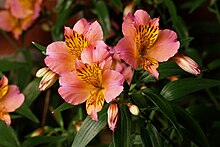Alstroemeria (syn. Alstremeria), commonly called the Peruvian Lily or Lily of the Incas, is a South American genus of about 120 species of flowering plants. Almost all of the species are restricted to one of two distinct centers of diversity, one in central Chile, the other in eastern Brazil. Species of Alstroemeria from Chile are winter-growing plants while those of Brazil are summer-growing. All are long-lived perennials except A. (Taltalia) graminea, a diminutive annual from the Atacama Desert of Chile.
The genus was named for the Swedish baron Clas Alströmer (Claus von Alstroemer 1736 - 1794) by his close friend Carolus Linnaeus. The plant was first described by the French botanist Louis Feuillée. The plant's seeds were among many collected by Alströmer on a trip to South America in 1753.
The plants are distinctive vegetatively, with a rootstock consisting of a slender rhizome or group of rhizomes (the "crown"). Storage roots consist of sausage-like water storing structures "suspended" from the rhizome by major roots. In this way the root system resembles that of dahlias. Above-ground shoots may be very short in some alpine Andean species (a few inches tall) or up to about 5 feet (1.5 m) tall in other species. Each year (more often in some hybrids) up to 80 new shoots are produced from the rootstock and each terminates in an umbel of a few up to 10 or so flowers.
Perhaps the most fascinating- and telltale- morphological trait of Alstroemeria and its relatives is the fact that the leaves are resupinate, that is, they twist from the base so that what appears to be the upper leaf surface is in fact the lower leaf surface. This very unusual botanical feature is easily observed in the leaves on cut flowers from the florist.
The flowers of Alstroemeria are generally showy. All six tepals (tepal denotes either petal or sepal when both are similar, as in lilies, amaryllis, etc.) are roughly similar. In some species two tepals are enlarged and vividly colored and act as "flags" for pollination. The ovary is inferior and the seeds are hard and rounded. Alstroemeria is named after the Swedish botanist Baron Klas von Alstroemer.
 Many hybrids and about 190 cultivars have been developed, with different markings and colors, ranging from white, golden yellow, and orange, to apricot, pink, red, purple, and lavender. The most popular and showy hybrids commonly grown today result from crosses between species from Chile (winter-growing) with species from Brazil (summer-growing). This strategy has overcome the problem of seasonal dormancy and resulted in plants that are evergreen, or nearly so, and flower for most of the year. This breeding work derives mainly from trials that began in the United States in the 1980s. The flower, which resembles a miniature lily, is very popular for bouquets and flower arrangements in the commercial cut flower trade. It has a vase life of about two weeks. It is sometimes also called 'Ulster Mary' (a corruption of the genus name).
Many hybrids and about 190 cultivars have been developed, with different markings and colors, ranging from white, golden yellow, and orange, to apricot, pink, red, purple, and lavender. The most popular and showy hybrids commonly grown today result from crosses between species from Chile (winter-growing) with species from Brazil (summer-growing). This strategy has overcome the problem of seasonal dormancy and resulted in plants that are evergreen, or nearly so, and flower for most of the year. This breeding work derives mainly from trials that began in the United States in the 1980s. The flower, which resembles a miniature lily, is very popular for bouquets and flower arrangements in the commercial cut flower trade. It has a vase life of about two weeks. It is sometimes also called 'Ulster Mary' (a corruption of the genus name).Most cultivars available for the home garden will bloom in the late spring and early summer. The roots are hardy to a temperature of 23 °F (−5 °C). The plant requires at least six hours of morning sunlight, regular water, and well-drained soil.
Source, Images: http://en.wikipedia.org/wiki/Alstroemeria













0 comments:
Post a Comment